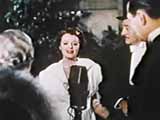|
The opening of What Price Hollywood?--the film opens, incidentally, in Hollywood itself, not in the provinces far from the starlight--is very much tongue-in-check: to light, jazzy music, close-ups of the hands of Mary Evans (Constance Bennett) flipping through a fan magazine alternate with shots of her dressing and applying make-up in the style modelled in the magazine's pages, followed by a shot of a full-page photograph of Greta Garbo and Clark Gable, which Mary folds in half, displacing Garbo and hugging Gable's picture to her, muttering her love in mock-Swedish accents.
She then folds up the Murphy bed in her tiny apartment and heads off to work as a waitress at the Brown Derby. Here, where most of the movie talk alternates between mild cynicism and apparent braggadocio, she meets her eventual mentor, the alcoholic director Max Carey (played by Lowell Sherman, a sometimes director himself) whom she steers through a potentially embarrassing opening night at Grauman's and eventually home to his bed (while she, in something of a gender-role reversal, curls up on his couch). In gratitude ("You're a great kid!"), he arranges a small part for her, which she plays very awkwardly at first but eventually turns into a triumph after much (intentionally comic) rehearsing at home. Her quick rise to stardom is conveyed in a montage sequence of movie marquees attesting to her growing fame. Despite newspaper gossip (in the "You Ask Me!" column) hinting at a romantic link between the sinking director and his rising protege, their relationship remains breezily professional, the love interest being provided by a handsome, polo-playing socialite who woos and weds Mary in the space of a few screen minutes.
Unlike later versions of the story, the chief source of conflict here is between the movie world (full of quips and wisecracking) and the outside world (her husband Lonny's rather staid, conventional world, heavy with gender expectations). For Mary, part of being a star is the long hours of waiting and the hard work it demands (e.g., "OK for sound" is a refrain running through the soundstage scenes). Another part is being able to relate to the offbeat characters who live wholly in this world (like the perpetually agitated producer, Saxe, who boasts at her wedding, "We broke all the house records for this church"). Lonny quickly discovers he can tolerate very little of all this. Ultimately, Mary's commitment to her work--she defends her "cheap and vulgar" world against her husband's carping and befriends Carey after he is fired for going on a bender--leads to divorce. Carey continues to decline (appearing drunk on her set) and eventually lands in jail. When she bails him out, he returns home, hungover and despondent, to a her large, empty mansion and shoots himself, bringing down scandal and disgrace on "America's Pal." Mary vows to clear her name for the sake of her son (born to her after Lonny left), but is forced to flee to France to thwart her husband's apparent attempt to gain custody of the boy. One day, in her garden, Mary is confronted, in what can only be regarded as a mock-heroic send-up of the slapdash Hollywood happy ending, with a suddenly (if inexplicably) repentant Lonny, who swears his reborn love, reproposes and gathers her into his arms, but not before she can receive a telegram from Saxe offering her a part in his new picture.
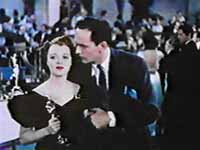 When Selznick remade the film five years later, almost everything of importance was changed: the mentor and lover were combined into a single figure, the fast-fading alcoholic star, Norman Maine (Frederic March); the heroine, Esther Blodgett (Janet Gaynor, often a symbol of domestic fidelity in prior roles) was made more naive and provincial (her "pioneer" grandmother is her major source of inspiration); and, most significantly, the emphasis was shifted from making movies to the downwardly spiraling domestic life of the two stars. Selznick very much wanted the picture to be comic in tone up to the point of Maine's suicide (his naked walk into the ocean), but despite Selznick's best efforts16 the film really remains a thoroughgoing melodrama with only a few, not particularly joyful, comic moments. What Frank McConnell writes about all three versions of the film is, in my view, very much truer of the 1937 and 1954 versions, where the melodrama of aspiration and anguish which is stardom is virtually unrelieved by a self-reflexive humor about movie-making: When Selznick remade the film five years later, almost everything of importance was changed: the mentor and lover were combined into a single figure, the fast-fading alcoholic star, Norman Maine (Frederic March); the heroine, Esther Blodgett (Janet Gaynor, often a symbol of domestic fidelity in prior roles) was made more naive and provincial (her "pioneer" grandmother is her major source of inspiration); and, most significantly, the emphasis was shifted from making movies to the downwardly spiraling domestic life of the two stars. Selznick very much wanted the picture to be comic in tone up to the point of Maine's suicide (his naked walk into the ocean), but despite Selznick's best efforts16 the film really remains a thoroughgoing melodrama with only a few, not particularly joyful, comic moments. What Frank McConnell writes about all three versions of the film is, in my view, very much truer of the 1937 and 1954 versions, where the melodrama of aspiration and anguish which is stardom is virtually unrelieved by a self-reflexive humor about movie-making:
Oddly, whenever Hollywood decides to become 'serious' about itself, it too accedes to this well-established myth of the star's psychic and sexual emptiness--a fact which should serve critics and novelists clear notice that the myth contains a fallacy. In all three versions of A Star Is Born, the female Star leads a life of frustration and off-screen agony caused by her 'discoverer' and lover, the ineffectual, alcoholic male Star (170).
Certainly, McConnell is right about the strained seriousness of the 1937 Star (and about its "odd" equation of "emptiness" with the truth of stardom). What the film proposes as the basic myth of stardom implies an almost vicious economy of means: one established star must be extinguished for every new star who ascends to the empyrean (a process watched dispassionately by the Darwinian press agent Libby, who expresses not the slightest sympathy for dissolute, fallen Maine).
The way in which the film ends points clearly to the most important individual in its making. Vicki Lester (Esther) braces herself and announces to an international radio audience, "Hello, everybody. This is Mrs. Norman Maine," after which there is a cut to these same words in the script, words Selznick himself had written after preview audiences had indicated that the original ending, Vicki's collapse on seeing Norman's footprint in the sidewalk outside Grauman's, was unsatisfactory.17
Selznick's individual triumph was completed before the Hollywood community at the Academy awards: although the picture received six nominations, it received only one award, for "original story," given to director Wellman and Robert Carson, who co-wrote the original (but little used) first treatment. In a legendary public moment, Wellman, in a gesture eerily like Vicki Lester's, approached Selznick and offered him the Oscar: "Here, you deserve this--you wrote more of it than I did."18 Selznick (then the leading independent producer in Hollywood and on the verge of making Gone with the Wind) could not have concocted a better ending.
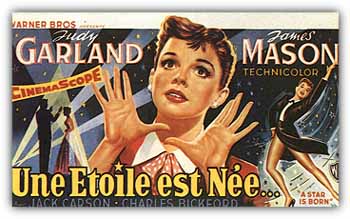
Movie poster for A Star is Born (1954).
The 1954 Star, which follows the 1937 Star closely, is perhaps most remarkable for its very complex, albeit ultimately self-contradictory, contemplation of Judy Garland: as individual, actress, movie star, singer and larger-than-life celebrity. By 1950, Garland, the once spunky and wistful girl with the astounding voice, had become "twenty pounds overweight, jowly and thick-waisted" (Jennings, 325). When MGM fired her, she made a half-hearted attempt at suicide. Over the next four years, though, Garland discovered her enormous--and, for one who had always operated at an imagistic remove in the movies, surprising--power to move audiences with her singing. (These were the years in which the Garland cult was created, a cult that subsumes her movie stardom under the larger myth of the suffering, dying artist.) But she also discovered, and displayed, the great cost of her art: for instance, three weeks into her record run (October 1951-February 1952) at the Palace in New York, she collapsed on stage of "nervous exhaustion" and had to be hospitalized, only to return five nights later to even greater acclaim. The fictional sufferings of Esther Blodgett could hardly compete with the real trials of Judy Garland, trials that Garland willingly ascribed to a Hollywood community more interested in profits than persons:
After four years away from the sound stages, Garland's highly publicized comeback in A Star is Born was more dramatically compelling than the film's own story. . . . Garland had begun to project a version of herself as the victim of an exploitative Hollywood system that had forced drugs on her as a child [to control her weight], exploited her creative talents until they were exhausted, and then dropped her after she collapsed from years of physical and psychological abuse. (Jennings, 326)
What ultimately muddles the treatment of great celebrity here, though, is that in terms of her individual career Judy Garland was then much closer to Norman Maine than Esther Blodgett, the key difference being that Garland, in her self-destructive trajectory, saw her talent broaden and deepen rather than dissipate. In attempting to come to some narrative terms with a kind of celebrity that far exceeded movie stardom, Hollywood (Warner Bros., director Cukor, screenwriter Moss Hart et al.) was perhaps trying to encompass to a new type of star, one created outside its full control. That it ultimately failed is evidenced by the star who appeared in American popular culture so dramatically shortly after the Garland Star was released, Elvis Presley. Suffice it to say that none of the many movies Presley made came anywhere near the essence of his star quality--in fact, they do little more than utilize his popularity as a selling point for a series of innocuous films (which did do well at the box office). But by then Hollywood was hardly a "community" as it had been in the heyday of the studio system--and Presley was hardly an "individual" who lived there in any sense, including the most literal.
page 6 of 9
 
Go to:
Introduction
Part One: The emergence of the star system
Part Two: The real, the "reel," and fan magazines
Part Three: The selling of stars
Part Four: The close-up and Alice Adams
Part Five: Cultural self-importance and A Star is Born
Part Six: Studio battlers--James Cagney and Bette Davis
Part Seven: The power of stars, the power of agents, and Jimmy Stewart
Wrap-up
Notes
Works Cited
Brian Gallagher is a professor of English and film at the City University of New York (LaGuardia).
|


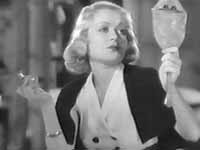 In 1932, David O. Selznick, a "vice president in charge of production" at RKO-Pathé and still very much a young man on the make, put together a script for What Price Hollywood? The resulting film (directed by George Cukor) is, as Robert Sklar notes in Movie-Made America, "swift, brash, a little sensational, risque, cynical and satirical" (192). In 1937 the film was remade and shot in newly perfected Technicolor by Selznick International Pictures (his newly created, high-budget independent production company) and re-titled, at the supposed suggestion of Jock Whitney (that millionaire sportsman and investor about town), A Star Is Born . This second version--directed by William Wellman, but created from start to finish by Selznick--is, again quoting Sklar, "far more self-conscious: the movie game has become a cultural institution" (192). And when the film was remade a second time, in Technicolor and Cinemascope by Warners in 1954 (with Cukor again directing), its ambition was even more grandiose: to fuse the story of the film's heroine with the very public melodrama of its singer-star, Judy Garland.
In 1932, David O. Selznick, a "vice president in charge of production" at RKO-Pathé and still very much a young man on the make, put together a script for What Price Hollywood? The resulting film (directed by George Cukor) is, as Robert Sklar notes in Movie-Made America, "swift, brash, a little sensational, risque, cynical and satirical" (192). In 1937 the film was remade and shot in newly perfected Technicolor by Selznick International Pictures (his newly created, high-budget independent production company) and re-titled, at the supposed suggestion of Jock Whitney (that millionaire sportsman and investor about town), A Star Is Born . This second version--directed by William Wellman, but created from start to finish by Selznick--is, again quoting Sklar, "far more self-conscious: the movie game has become a cultural institution" (192). And when the film was remade a second time, in Technicolor and Cinemascope by Warners in 1954 (with Cukor again directing), its ambition was even more grandiose: to fuse the story of the film's heroine with the very public melodrama of its singer-star, Judy Garland.
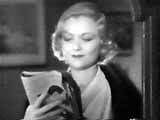
 When Selznick remade the film five years later, almost everything of importance was changed: the mentor and lover were combined into a single figure, the fast-fading alcoholic star, Norman Maine (Frederic March); the heroine, Esther Blodgett (Janet Gaynor, often a symbol of domestic fidelity in prior roles) was made more naive and provincial (her "pioneer" grandmother is her major source of inspiration); and, most significantly, the emphasis was shifted from making movies to the downwardly spiraling domestic life of the two stars. Selznick very much wanted the picture to be comic in tone up to the point of Maine's suicide (his naked walk into the ocean), but despite Selznick's best efforts
When Selznick remade the film five years later, almost everything of importance was changed: the mentor and lover were combined into a single figure, the fast-fading alcoholic star, Norman Maine (Frederic March); the heroine, Esther Blodgett (Janet Gaynor, often a symbol of domestic fidelity in prior roles) was made more naive and provincial (her "pioneer" grandmother is her major source of inspiration); and, most significantly, the emphasis was shifted from making movies to the downwardly spiraling domestic life of the two stars. Selznick very much wanted the picture to be comic in tone up to the point of Maine's suicide (his naked walk into the ocean), but despite Selznick's best efforts